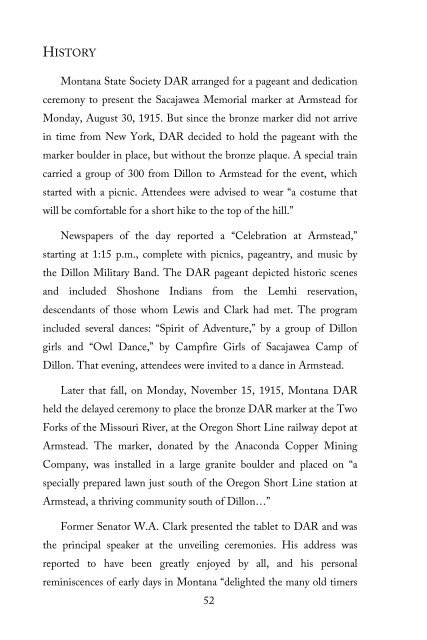Montana's DAR Markers . . . Honoring Where History Was Made
This book is a 200-page thank you to the women of Montana State Society Daughters of the American Revolution for their work in placing historical markers across the state of Montana. Starting in 1908, Montana DAR has installed 70 historical markers across the state. Of those, 33 remain. This book records why the markers’ sites were selected, their history, and the backstory of each.
This book is a 200-page thank you to the women of Montana State Society Daughters of the American Revolution for their work in placing historical markers across the state of Montana. Starting in 1908, Montana DAR has installed 70 historical markers across the state. Of those, 33 remain. This book records why the markers’ sites were selected, their history, and the backstory of each.
You also want an ePaper? Increase the reach of your titles
YUMPU automatically turns print PDFs into web optimized ePapers that Google loves.
HISTORY<br />
Montana State Society <strong>DAR</strong> arranged for a pageant and dedication<br />
ceremony to present the Sacajawea Memorial marker at Armstead for<br />
Monday, August 30, 1915. But since the bronze marker did not arrive<br />
in time from New York, <strong>DAR</strong> decided to hold the pageant with the<br />
marker boulder in place, but without the bronze plaque. A special train<br />
carried a group of 300 from Dillon to Armstead for the event, which<br />
started with a picnic. Attendees were advised to wear “a costume that<br />
will be comfortable for a short hike to the top of the hill.”<br />
Newspapers of the day reported a “Celebration at Armstead,”<br />
starting at 1:15 p.m., complete with picnics, pageantry, and music by<br />
the Dillon Military Band. The <strong>DAR</strong> pageant depicted historic scenes<br />
and included Shoshone Indians from the Lemhi reservation,<br />
descendants of those whom Lewis and Clark had met. The program<br />
included several dances: “Spirit of Adventure,” by a group of Dillon<br />
girls and “Owl Dance,” by Campfire Girls of Sacajawea Camp of<br />
Dillon. That evening, attendees were invited to a dance in Armstead.<br />
Later that fall, on Monday, November 15, 1915, Montana <strong>DAR</strong><br />
held the delayed ceremony to place the bronze <strong>DAR</strong> marker at the Two<br />
Forks of the Missouri River, at the Oregon Short Line railway depot at<br />
Armstead. The marker, donated by the Anaconda Copper Mining<br />
Company, was installed in a large granite boulder and placed on “a<br />
specially prepared lawn just south of the Oregon Short Line station at<br />
Armstead, a thriving community south of Dillon…”<br />
Former Senator W.A. Clark presented the tablet to <strong>DAR</strong> and was<br />
the principal speaker at the unveiling ceremonies. His address was<br />
reported to have been greatly enjoyed by all, and his personal<br />
reminiscences of early days in Montana “delighted the many old timers<br />
52





